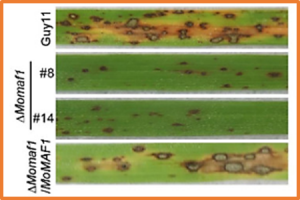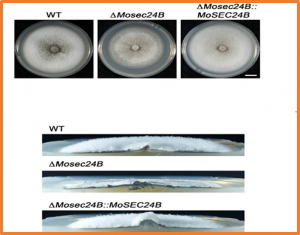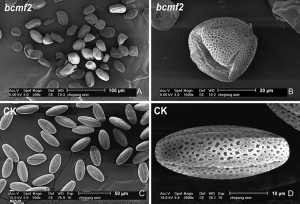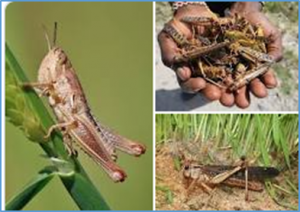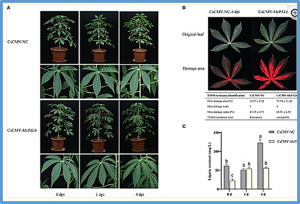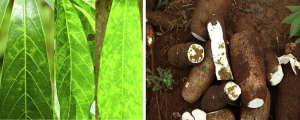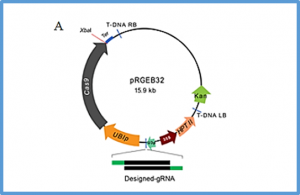In eukaryotes, Maf1 is an essential and specific negative regulator of RNA polymerase (Pol) III. Pol III, which synthesizes 5S RNA and transfer RNAs (tRNAs), is suppressed by Maf1 under the conditions of nutrient starvation or environmental stress. Here, we identified M. oryzae MoMaf1, a homolog of ScMaf1 in budding yeast. A heterogeneous complementation assay revealed that MoMaf1 restored growth defects in the ΔScmaf1 mutant under SDS stress.
The endoplasmic reticulum (ER) acts as the starting point of the secretory pathway, where approximately one-third of the proteins are correctly folded and modified, loaded into vesicles, and transported to the Golgi for further processing and modification. In this process, COPII vesicles are responsible for transporting cargo proteins from the ER to the Golgi. Here, we identified the inner shell subunit of COPII vesicles (MoSec24B) and explored the importance of MoSec24B in the rice blast fungus.
Chinese cabbage (Brassica rapa L. ssp. pekinensis) is one of the major vegetable crops in East Asia, and the utilization of male-sterile line is an important measure for its hybrid seed production. Herein, we isolated three allelic male-sterile mutants, msm1-1, msm1-2 and msm1-3, from an ethyl methane sulfonate (EMS) mutagenized population of Chinese cabbage double-haploid (DH) line ‘FT’, whose microspores were completely aborted with severely absent exine, and tapetums were abnormally developed.
Salt stress is one of the main types of environmental stress leading to a reduction in crop yield worldwide. Plants have also evolved a variety of corresponding regulatory pathways to resist environmental stress damage. This study aimed to identify a SbMYBHv33 transcription factor that downregulates in salt, drought, and abscisic acid (ABA) in the salt-tolerant inbred line sorghum M-81E.
Low Phosphate Root (LPR) encodes a protein localized to the endoplasmic reticulum (ER) and cell wall. This gene plays a key role in responding to phosphate (Pi) deprivation, especially in remodeling the root system architecture (RSA). An identification and expression analysis of the OsLPR family in rice (Oryza sativa) has been previously reported, and OsLPR5, functioning in Pi uptake and translocation, is required for the normal growth and development of rice.
In plants, the endomembrane system is tightly regulated in response to environmental stresses for maintaining cellular homeostasis. Autophagosomes, the double membrane organelles forming upon nutrient deprivation or stress induction, degrade bulky cytosolic materials for nutrient turnover. Though abiotic stresses have been reported to induce plant autophagy, few receptors or regulators for selective autophagy have been characterized for specific stresses.
The phase transition from solitary to gregarious locusts is crucial in outbreaks of locust plague, which threaten agricultural yield and food security. Research on the regulatory mechanisms of phase transition in locusts has focused primarily on the transcriptional or posttranslational level. However, the translational regulation of phase transition is unexplored. Here, we show a phase-dependent pattern at the translation level, which exhibits different polysome profiles between gregarious and solitary locusts.
The two-spotted spider mite (TSSM) is a devastating pest of cassava production in China. Lignin is considered as an important defensive barrier against pests and diseases, several genes participate in lignin biosynthesis, however, how these genes modulate lignin accumulation in cassava and shape TSSM-resistance is largely unknown.
As one of the most important food crops, cassava (Manihot esculenta) is the main dietary source of micronutrients for about 1 billion people. However, the ionomic variation in cassava and the underlying genetic mechanisms remain unclear so far. Herein, genome-wide association studies were performed to reveal the specific single nucleotide polymorphisms (SNPs) that affect the ionomic variation in cassava.
The xa13 gene is a recessive resistance gene against Xanthomonas oryzae pv. oryzae (Xoo) found in several rice varieties. Activation of this gene will trigger the formation of sucrose as a nutrient supply to Xoo for their growth in the plant. The disruption of this recessive gene expression in the plant can affect the negative impact of the gene, and recently can be created using clustered regularly interspaced short palindromic repeats (CRISPR) system using CRISPR-associated protein-9 (CRISPR/Cas9) technology that requires gRNA to recognize the targeted-sequence


 Curently online :
Curently online :
 Total visitors :
Total visitors :
